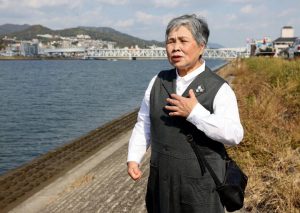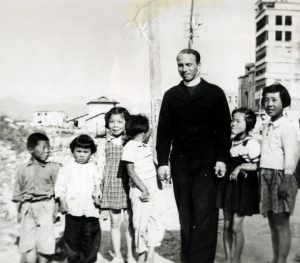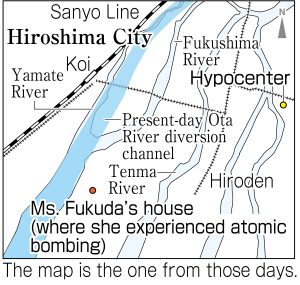Survivors’ Stories: Sueko Fukuda, 82, Asakita Ward, Hiroshima – Lost eldest sister and thrown into dire straits after the war
Nov. 21, 2022
First testimony initiated by Peace Memorial Hall’s special exhibitions results in memoir
by Kyoko Niiyama, Staff Writer
Sueko Fukuda, 82, was exposed to the atomic bomb when she was five years old. She lost her eldest sister, Ayako, then 16, in the atomic bombing. The image of her mother, Chie, collapsing into tears beside Ayako’s body, is still etched into her memory. She says, “My heart still aches when I think of my mother’s sorrow and grief.”
Ms. Fukuda was the youngest of six children and was living in Minamikanon-machi (Nishi Ward, Hiroshima). On the morning of August 6, 1945, after finishing breakfast, she was sitting on the veranda of her house with her second eldest sister, Haruko. Then, suddenly there was a roaring sound, and she lost consciousness. Her house was located about 2 kilometers from the hypocenter. She has no memory of the moment, and all she knows is that the roof of her house had collapsed due to the bomb’s blast and that she was pulled away by her mother and evacuated.
She and her mother fled in the direction of the former Fukushima River (present-day Ota River diversion channel). On her way there, she passed a boy of about junior high school age, with a bamboo stick piercing one eye. His face was covered in blood. She was shocked by his ghastly appearance.
When they reached a farmhouse along the former Yamate River, her mother said, “Please wait here,” and went back home. In the river in front of her, which became shallow due to the low tide, injured people were walking in droves. Many of them were too exhausted to reach the other side of the river. Moaning was heard here and there. Being left alone, she was scared.
Tamako, her elder brother’s wife, came to meet her. Walking across the former Yamate River, Ms. Fukuda headed for Koi (present-day Nishi Ward). She and Tamako got on a track for carrying injured people, and went to Tamako’s parents’ house in the Rakurakuen region (Saeki Ward). Later on, her parents, brothers and sisters fled there as well.
Her sister Ayako, who was engaged in labor service in the city center, suffered serious injuries to both of her legs and was accommodated to a national school (now an elementary school) in the village of Hera (now part of Hatsukaichi City). Her family then took her to the Rakurakuen region. Her wounds were infected with maggots. Her father Senkichi desperately searched in vain for peaches that Ayako wanted while suffering from her ordeal. On August 20, she passed away.
Ms. Fukuda cannot forget the scene when her family put her sister’s body onto a cart bound for cremation and pulled it. Her mother cried and collapsed there. She says, “I was looking at her face beside her without being able to speak to her.”
The atomic bombing completely changed her life. After the war, her house was rebuilt. But her father was often ill in bed due to effects of the atomic bomb. Her family sometimes ran out of food and had to endure hunger for days. After graduating from Minami Kanon Elementary School, she started working to support her family instead of attending junior high school.
It was the Catholic faith that lent mental support to her in those hard days. Before the atomic bombing, her family would attend Noboricho Church (now located in Naka Ward) every week. At the end of 1945, a barrack was built in the burnt ruins of the church, where she offered prayers and consoled the spirits of A-bomb victims together with Father Hubert Cieslik (1914-1998) from Germany, and others.
Ms. Fukuda got married at the age of 19 and raised five children. She has tried not to think about her sister’s death and her postwar life because the memory fills her heart with sorrow.
Last year, however, a turning point arrived. The Hiroshima National Peace Memorial Hall for the Atomic Bomb Victims located in the city’s Naka Ward held special exhibitions featuring “priests who survived the atomic bombing,” and used for its pamphlet a photograph of Father Cieslik, along with Ms. Fukuda and some other children who were standing on the rubble at Hatchobori in the city center in 1946. It was totally unexpected. There are no longer others except Ms. Fukuda who know of those days. She thought it must be some kind of fate. The Memorial Hall staff listened to her experience of the atomic bombing and helped her create her first memoir.
She had always blocked out the memory of “that day.” However, by looking back little by little, she says, “I came to sort out my feelings about it.” She still sheds tears when she thinks about her past, but now she thinks that she is going to talk about it directly to her family while she is alive.
(Originally published on November 21, 2022)










